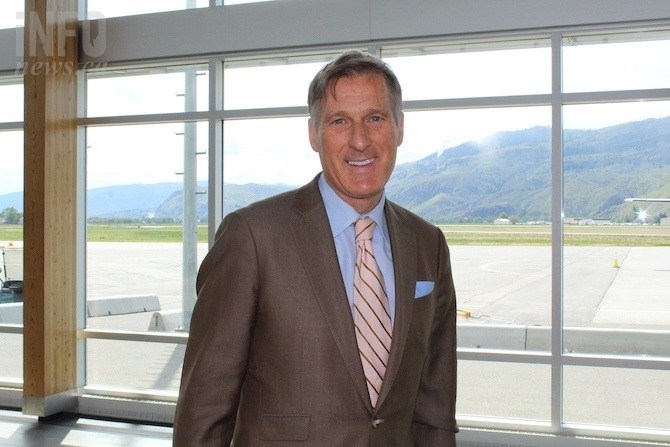
Maxime Bernier at Kamloops Airport in 2019.
(JENNA WHEELER / iNFOnews.ca)
September 22, 2021 - 6:00 AM
Even while the federal election was decided by large margins in the Okanagan and Thompson ridings, voters also showed some of the strongest support in the country for the People’s Party of Canada.
Nationally and provincially, the People’s Party, led by Maxime Bernier, took 5.1% of the popular vote. That’s more than double what the fledgling party collected in 2019 when only 1.62% of Canadians voted for it.
In the North Okanagan-Shuswap riding, the party collected double the provincial average with 10.3% of the vote.
Conservative Mel Arnold was easily re-elected there with 46.7% of the vote. Even if the PPC had not run a candidate there and all those votes went to the second-place finisher, the NDP’s Ron Johnston would still have finished a distant second, with about 29% of the vote instead of the 19.1% he did get.
There’s nothing to say that PPC voters all come from the same political stripe but, given that Bernier finished a close second to Andrew Scheer in the 2017 Conservative leadership race, it seems likely most of the party’s backers would be Conservatives, not NDPers.
“We have to be careful not to do a one-to-one mapping," Hamish Telford, a political science professor at the University of the Fraser Valley, told iNFOnews.ca. “The People’s Party started as a protest party. It draws discontents from all sectors as well as it was drawing in people who don’t otherwise vote.”
That being said, Telford believes Bernier did syphon some votes from Conservatives that might have made a difference in some close ridings, particularly in Ontario.
While there are many planks in the party’s platform, a key element of his election was Bernier joining anti-vaccine rallies and pushing back against COVID restrictions.
“It became pretty clear in the campaign, among the discontents that they were pulling in, that they were really mobilizing anti-vaxxers or the anti-vaxxers mobilized around them,” Telford said. “I certainly hope that, whenever the next election is, we’re not talking about vaccinations.”
The North Okanagan-Shuswap’s support for the PPC wasn’t the strongest in the province. Prince George-Peace River-Northern Rockies voted 10.5% in favour of the PPC. The Peace River is the least vaccinated part of the province and has one of the highest COVID-19 infection rates.
READ MORE: New cases of COVID-19 in B.C. shifting north but Interior Health still heavily impacted
“We’re seeing a correlation between low vaccination rates and high PPC votes for sure,” Telford said.
He said that some of those voters have a “frontier” mentality where they want to do things on their own, without government interference and that fits in well with Bernier’s libertarian, get-rid-of-government views.
While the North Okanagan-Shuswap was a particular hotspot for PPC support locally, the rest of the Okanagan also exceeded the provincial average.
South Okanagan-West Kootenay voted 7.7 % in favour of the PPC.
That riding was won by incumbent NDP candidate Richard Cannings with 41.1% of the vote. It’s a riding where the PPC vote may have made a difference.
If the 4,646 people who voted for the PPC’s Sean Taylor had voted unanimously for the Conservative’s Helena Konanz, that would have put her ahead of Cannings. But, again, there’s nothing to say all those voters would have gone to the Conservatives if the PPC hadn't been in the race.
Kelowna-Lake Country voted 7.2% in favour of the PPC while it was a similar score in Central Okanagan-Similkameen-Nicola at 7.3%.
Kamloops-Thompson-Cariboo was closer to the provincial average at 5.8%.
Northwestern B.C., the Kootenays and the eastern Fraser Valley also showed strong support for the People’s Party but that dwindled significantly in Greater Vancouver and on Vancouver Island.
In all, the People’s Party of Canada collected 814,547 votes across the country with 105,412 in B.C., of which almost 23% (24,178) were in the five Thompson and Okanagan ridings where candidates ran.
Across the country, support for the PPC was strongest in Alberta, reeling in 7.5% of the popular vote. It was weakest in Newfoundland and Labrador at 2.5%, although only 2.8% of voters in Bernier’s home province of Quebec voted for his party.
No People’s Party of Canada candidates were elected.
By contrast, two Green Party candidates appear to have been elected, even though their popular vote plummeted from 6.55% in 2019 to 2.3% this year.
To Telford, that’s the key issue, that Bernier did not even come close to getting elected in his own riding.
“If Bernier had got a seat, he may have been able to get past the vaccine thing in the future,” Telford said. “There’s nobody arguing against deficits now so fiscal conservatives, I think, are looking for a home. If Bernier had got that seat, he could have made that his central plank and attracted fiscal conservatives and started to build a more coherent kind of political opposition. But that’s going to be difficult to do without a seat.”
READ MORE: Did Bernier's party split votes on the right? The answer is nuanced, expert says
To contact a reporter for this story, email Rob Munro or call 250-808-0143 or email the editor. You can also submit photos, videos or news tips to the newsroom and be entered to win a monthly prize draw.
We welcome your comments and opinions on our stories but play nice. We won't censor or delete comments unless they contain off-topic statements or links, unnecessary vulgarity, false facts, spam or obviously fake profiles. If you have any concerns about what you see in comments, email the editor in the link above.
News from © iNFOnews, 2021